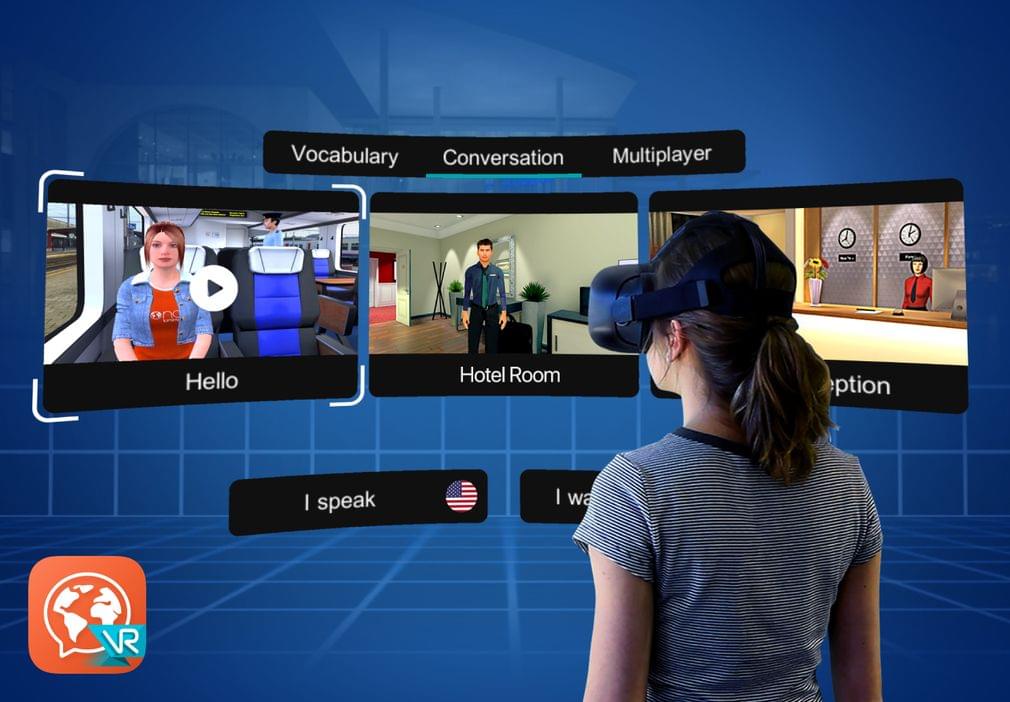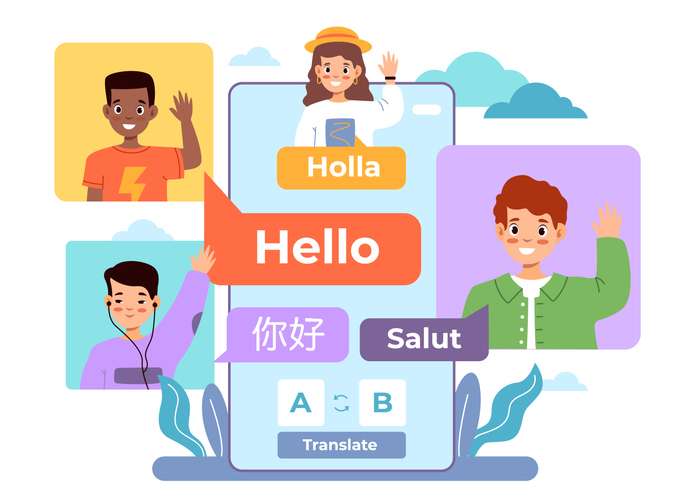You might have heard that childhood is the best time to learn a new language, and it's absolutely true.
Young children can learn foreign languages faster than teenagers and adults, and, often, they can learn to speak without an accent. If you want your child to be bilingual, then early childhood is the place to start.
But young children learn languages differently. Most don't have the patience or the interest to memorize grammar tables or lists of vocabulary words. For kids, language
Editor's Note: This article contains sponsored content.
How Early Can a Child Start Learning?
It's never too early to learn a language. After all, babies start learning their native language the moment they hear their parents speak. And if they're exposed to more than one language, their minds can tell the difference and keep them separate!
At the same time, not all language learning systems work for all kids. Children of different ages learn differently, and even within age groups, individuals may respond better to different types of activities.
Evaluating the Year-Round School System
Evaluating the Year-Round School System Read More
Babies and Toddlers
Did you know that a child can start learning a language before they know how to speak?
Programs for babies and toddlers should provide the opportunity to hear the language spoken by native speakers. Toddlers will also enjoy repeating back the names of familiar objects and putting words together into simple constructions.
Short videos work well for toddlers, especially if there's a simple story that they can follow.
Preschoolers
Immersive learning can be a great way to go for preschoolers.
Interactive stories and videos can teach children how words fit together, and how to use them to communicate. By listening and participating, preschool-aged children can learn naturally, using their innate curiosity and creativity.
Remember, though, that at this age, many children have an attention span of minutes. Moreover, many experts recommend that screen time be kept to a minimum. So choose programs that respect these guidelines.
Elementary Aged Kids
For kids aged six and above, it's all about the games.
Gamified exercises can teach kids about vocabulary, grammar, and usage. At the same time, feedback and rewards systems can keep them engaged in the process. Bite-sized, themed lessons keep things fresh.
Some elementary-aged kids are also able to benefit from structured learning techniques like formal grammar study and flash cards.
Tweens and Teens
Tweens and teens like games, too, but their learning style is often closer to that of adults. Language learning systems for older kids should focus on real-life situations and conversations that they can use.
Many tweens and teens can also benefit from formal grammar and analytical skills.
And, when it comes to young adults, social is everything. Look for apps that allow them to engage with other language learners, earn prizes, and compete with their peers.
The Best Apps and Websites to Help You Get Started
Language learning apps, websites, and online programs can be a great way to start your child on the road to learning a new language.
We've chosen a selection of programs for children of different ages that can help your child start learning a new language today.
1. LingoAce
Chinese Mandarin is the most widely spoken language in the world with over 1.2 billion speakers! Mandarin has often been dubbed the “language of the future,” and is an incredible skill for your child to have as they go through school and eventually begin a career.
LingoAce makes Mandarin Chinese engaging and immersive through a comprehensive language learning program. LingoAce is not just an app. By signing up for the LingoAce platform, each child gets to work with a team of four professionals (a teacher, course consultant, learning advisor, and technical support professional) in a course that's created specifically for the child.
With LingoAce’s tailor-made learning programs, children not only learn to understand and speak Chinese Mandarin, but they’ll also discover how to read and write important Chinese characters!
Studies have shown that there is actually a scientific link between learning Mandarin and improved mathematical ability. Since Chinese Mandarin uses visual characters and drawings rather than the English alphabet, it helps children use different parts of their brains. This leads to improved problem-solving abilities and artistic communication.
Who it's For:
LingoAce is for children between the ages of six and 15 who:
- Enjoy fun and educational online programs
- Want to learn new skills
- Are interested in Chinese culture and language
How it Works:
After an initial consultation and free trial lesson, LingoAce will develop a personalized curriculum for your child. In addition, the LingoAce professionals will tailor the program to fit your child's individual educational and scheduling needs. Younger children can be delighted by LingoAce’s gamified approach to learning and storytelling. They’ll be brought along on an adventure with Nana and Qiqui – solving puzzles and completing interactive games and challenges along the way.
LingoAce has over 4,000 teachers around the world. Graduates from the top 100 language universities, their team has the depth of expertise and diversity of experience to bring Chinese learning to life for every young learner.
Their passionate professionals have additional training that allows them to design curricula to suit the needs of every student, regardless of level or learning style.
How to Begin:
LingoAce is running a special promotion for you! If you purchase a package of lessons, you can receive up to 16 free lessons! Book your free trial lesson at the LingoAce website.
2. Duolingo
The Duolingo app doesn't need a lot of introduction. It's one of the most popular free language learning apps today. DuoLingo uses a gamified, conversational approach to teach a variety of languages, including:
- Spanish
- French
- Danish
- Dutch
- English
- German
- Hebrew
- Irish
- Hindi
- Japanese
- Korean
- Polish
- Swedish
- Turkish
- Welsh
And more. You can even become bilingual in languages from your favorite franchises, like High Valyrian from Game of Thrones and Klingon from Star Trek!
Who it's For:
This one is fun enough for elementary-aged children, but popular with teens and adults, too.
In addition, Duolingo's AI-driven learning will adapt lessons to every learner's level and pace.
How it Works:
Duolingo is a free app that you can download from your app store. It works on Android, as well as on iPad and iPhone.
The app breaks language learning down into fun games and bite-sized mini-lessons that teach speaking, reading, and listening skills.
Forget textbooks and flashcards. DuoLingo emphasizes real-world communication with basic words and everyday expressions. Lessons focus on real-life goals and language skills that you will use in actual communication.
It's social, too. You can link up with friends using the app, challenge yourself and others to maintain a streak, and more.
How to Begin:
Download the DuoLingo app from their website and get cracking!
3. Little Pim

Little Pim is a subscription-based online language learning program that teaches primarily through short videos voiced by native speakers.
Students can choose from 12 languages, including Arabic, Chinese, German, French, Hebrew, Russian, and others.
Who it's For:
Little Pim is for infants, toddlers, and young children under six.
How it Works:
Research has shown that between birth and age six, children have a unique window for language learning. Little Pim is aimed at this window.
The program operates on the principle of immersion. The program was developed by neuroscientists, language teachers, and parents.
Each lesson is a five-minute video focussing on a child-friendly vocabulary set.
You can play Little Pim videos on your computer, tablet, and on your TV through Chromecast and Roku.
How to Begin:
Go to the Little Pim website to start your free trial.
4. Rosetta Stone
Rosetta Stone is another heavy hitter in the world of educational apps, and it's easy to see why. This is a subscription-based program that allows you to choose from up to 24 of the world's most popular languages.
Rosetta Stone's language courses have been used by businesses for more than 25 years, and has become a trusted way for adults and children alike to learn a second language (or a third, or a fourth...)
Who it's For:
The app is for language learners of all ages. Rosetta Stone also has a special program for homeschoolers.
How it Works:
Rosetta Stone primarily works through immersion. Lessons are themed, for example, "greetings and introductions," and "work and school." Their patented speech recognition engine helps users to self-correct and perfect their pronunciation.
Additional coaching services from native speakers are available, too.
Rosetta Stone works online and off, through your mobile device. Subscribers can also download lessons onto their devices.
How to Begin:
Go to Rosetta Stone's website and start your free trial.
5. Babbel
Babbel is a subscription-based service. Language learners can choose from among 13 different languages and two different programs: app-based self-study and live online language classes with native speakers.
Who It's For:
Babel recommends the app for kids ages 14 and up, as some content and exercises may contain phrases that are less appropriate for younger children.
How it Works:
The Babel system was developed with the input of over 150 language experts.
There are two different lesson styles: a self-study app that involves interactive games and activities that focus on conversational skills, and online lessons with a live native speaker coach.
Both methods take a holistic approach, incorporating useful phrases, new words, and common constructions with grammar tips and language recognition to help you to perfect your pronunciation.
How to Begin:
You can get started now at Babbel's website.
6. Mondly

Mondly is an app that can teach you up to 41 different languages, including variants, such as British and American English, and the Portuguese spoken in either Portugal or Brazil.
It may not be as well known as DuoLingo, but many consider Mondly to be one of the best language learning apps on the market.
Who it's For:
Mondly is unique in that it doesn't just aim its lessons at English speakers. Speakers of many other languages can also use the app to learn a variety of other languages.
The gamified, short lesson approach makes Mondly a good choice for older children, teens, and adults. There's also a special program for younger kids.
People who prefer a structured approach will appreciate Mondly's grammar tables and vocabulary builders.
How it Works:
Each of Mondly's short, interactive lessons center on a theme, such as greetings or weather.
In addition, learners can use tools such as the chatbot to practice and reinforce learning.
Mondly Kids includes a variety of interactive games, exercises, and high-quality audio to make language learning fun.
How to Begin:
Download the Mondly app on Google Play or your favorite app store and get started.
7. Gus on the Go
Gus on the Go is an app-based learning system. Learners can choose between 30 languages, including vulnerable languages like Ingush.
Who it's For:
Gus on the Go is aimed at young children, from preschool through elementary age.
How it Works:
The Gus on the Go system utilizes short lessons, interactive games, stories, and videos to teach a broad variety of languages.
Lessons center on useful topics such as food, clothes, parts of the body, and so forth, and are voiced by native speakers.
How to Begin:
Download the Gus on the Go app from your favorite app store or from Amazon, and start your child's language learning adventure.
8. Fluent U
Fluent U is a subscription-based immersion language learning system that teaches through videos.
Who it's For:
Fluent U is aimed at older children, teens, and adults.
How it Works:
Language teachers often recommend that their students watch TV or movies in the target language, to understand how the language sounds and is used in real life.
Fluent U provides videos that you can stop and start as needed. In addition, videos have captions in the target language, and you can hover your cursor over each word for translation and usage suggestions.
You can also see specific words and phrases used in other videos to give a clearer idea of context.
You can watch Fluent U's videos online or download them to your device to watch at your leisure.
How to Begin:
Hop on over to the Fluent U website to start your free trial.
9. Muzzy
Muzzy is a subscription-based immersion system for language learning. The program itself was developed more than 30 years ago, and has recently been adapted into a combination website and app.
Who it's For:
Muzzy is aimed at children from preschool age to tweens. There are also special programs for homeschoolers, libraries, and schools.
How it Works:
Muzzy works on the principles of "see, say, learn." Children learn through animated stories in the target language featuring Muzzy and friends.
Using a variety of multisensory techniques, Muzzy is designed for a variety of learning styles. Each lesson builds on the previous one, and provides practice in speaking, listening, reading, and writing.
Muzzy is a combination website and app that includes videos and more than 400 interactive learning games. There are also vocabulary builders, printables, sing-a-longs, and full-length movies.
How to Begin:
Select the subscription plan that's right for you, and start learning!
10. DinoLingo
If you have a dinosaur-loving kid, DinoLingo could be the language learning app you're looking for. DinoLingo is a child-safe subscription-based service accessible through devices, computers, and your smart TV.
Who it's For:
DinoLingo is for kids aged two through ten.
How it Works:
DinoLingo helps children to learn any of 50 different languages. The system uses a multisensory, gamified approach, with short lessons and reward systems to encourage children to keep learning.
DinoLingo's library of more than 30,000 activities includes:
- Videos
- Games
- Songs
- Books
- Worksheets
- Flashcards
And more.
You can choose an individual account or a family subscription for up to four family members.
How to Begin:
Learn more at the DinoLingo website.
11. Mango Languages
Mango Languages is an award-winning app-based system developed by linguists. Users can choose between an incredible 70 languages.
Who it's For:
Language learners aged six to adult. Mango Languages is also one of the top-rated language learning apps for homeschoolers and distance learning.
How it Works:
Mango Languages focuses on speech and auditory comprehension. Learners listen to conversations between native speakers, which teach vocabulary, listening comprehension, grammar, pronunciation, and culture.
Users can use speech recognition and analysis technology to perfect their pronunciation.
Users can access Mango Languages online or off. There are also placement tests and progress tracking. In addition, each account can host up to five different learners.
How to Begin:
Hop on over to the Mango Languages website to start your free two-week trial.
Whatever your child's age, experience, or learning style, there's a language learning system for them. Get started today!


